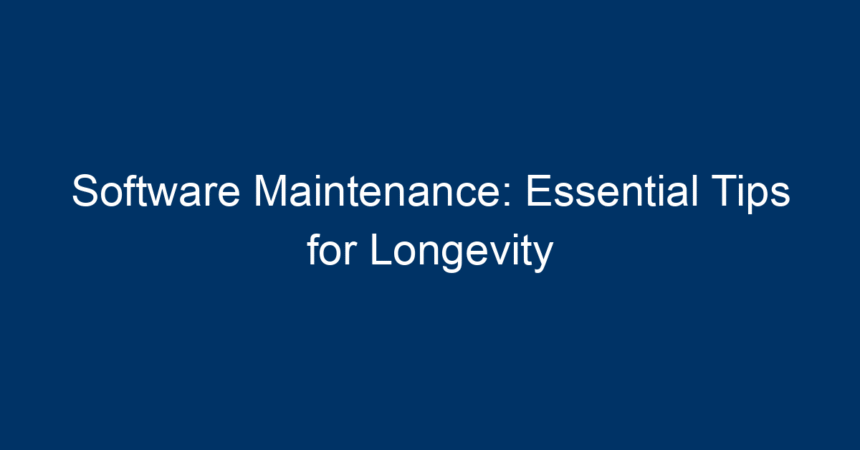In today’s fast-paced digital landscape, the longevity and effectiveness of software systems depend largely on proper maintenance. Software maintenance is not just a follow-up task; it’s a critical aspect of software development that ensures applications remain functional, secure, and relevant over time. In this comprehensive guide, we’ll explore essential tips for effective software maintenance that can help extend the life of your software and optimize its performance.
What is Software Maintenance?
Software maintenance refers to the process of modifying and updating software applications after delivery. This includes fixing bugs, improving performance, optimizing functionality, and adapting software to new hardware or operating environments. The goal of software maintenance is to enhance software longevity and ensure that users remain satisfied with their experience.
Types of Software Maintenance
-
Corrective Maintenance: This involves fixing defects or bugs that are discovered after the software is deployed. Corrective maintenance is vital to ensure the software functions as intended.
-
Adaptive Maintenance: This type involves updating software to accommodate changes in the environment, such as new operating systems or hardware upgrades. Adaptive maintenance is essential for keeping software relevant.
-
Perfective Maintenance: This focuses on enhancing the software by adding new features or improving existing ones, aligning the software with user needs and market trends.
- Preventive Maintenance: This proactive approach involves making changes to prevent future defects. Regular code reviews and updates fall into this category.
Best Practices for Effective Software Maintenance
To maximize the longevity of your software, it’s crucial to adopt effective maintenance practices. Here are some essential tips:
1. Regular Updates and Patching
Maintaining updated software is one of the most critical aspects of software maintenance. Regular updates and patches address security vulnerabilities, fix bugs, and introduce new features that enhance user experience. Implementing a schedule for regular updates can help keep your software secure and functional.
2. Documentation
Good documentation is necessary for effective software maintenance. Comprehensive documentation of the software’s architecture, APIs, and modules facilitates easier updates and modifications. It helps new team members to understand the software quickly, minimizing onboarding time and errors.
3. Automated Testing
Automated testing helps identify bugs and issues quickly, allowing for more efficient maintenance. Incorporating automated tests into your software development lifecycle ensures that changes do not break existing functionality. Regular testing also helps maintain software quality over time.
4. Version Control
Using version control systems (like Git) is essential for tracking changes in the codebase. It allows developers to revert to previous versions if necessary, making collaboration easier and reducing the risk of issues during the maintenance phase.
5. Monitoring and Performance Analysis
Continuous monitoring of software performance can help identify potential issues before they escalate. Using performance monitoring tools will provide insights into bottlenecks, user interactions, and overall system performance, enabling you to take action when necessary.
6. User Feedback and Adaptation
User feedback is invaluable for software maintenance. Regularly collecting and analyzing user input allows you to understand how well your software meets their needs. Based on this feedback, you can implement necessary changes, enhancing user satisfaction.
The Role of Agile Methodology in Software Maintenance
Agile methodologies can significantly improve the effectiveness of software maintenance. By emphasizing iterative development and continuous feedback, Agile practices encourage teams to adapt quickly to changing requirements and market conditions. This flexibility allows for more responsive maintenance strategies and enhances overall software longevity.
Agile Techniques to Implement
-
Sprint Planning: Plan short development cycles (sprints) dedicated to maintenance tasks. This approach ensures that maintenance is regularly integrated into your development workflow.
-
Daily Stand-ups: Conduct daily meetings to discuss potential issues, progress, and user feedback. This encourages open communication among team members and enables swift action.
- Retrospectives: After each sprint, hold retrospective meetings to discuss what went well and what could be improved regarding software maintenance. This reflection helps teams adapt and enhance their strategies for future maintenance.
Cost-Benefit Analysis of Software Maintenance
While software maintenance may seem costly, the long-term benefits far outweigh the initial expenditures.
Cost Factors:
-
Labor Costs: The time and effort required for maintenance activities can add up, especially if not planned properly.
- Downtime Costs: Neglecting maintenance can lead to downtime, which may result in lost revenue and decreased customer trust.
Benefits:
-
Increased Longevity: Regular maintenance extends the life of your software, allowing you to maximize the return on your investment.
-
Enhanced User Satisfaction: Proactive maintenance helps deliver a better user experience, which is essential for retaining customers and attracting new ones.
- Strategic Adaptation: Timely updates prepare your software to adapt to technological advancements and market trends, keeping it competitive.
Future Trends in Software Maintenance
As technology continues to evolve, software maintenance practices can also be expected to change. Here are some key trends to watch for:
-
Artificial Intelligence and Machine Learning: AI can help automate maintenance tasks, predict potential issues, and enhance decision-making processes related to software updates.
-
DevOps Integration: The integration of development and operations teams fosters a culture of collaboration, resulting in faster and more efficient maintenance practices.
-
Cloud-Based Solutions: As more applications move to the cloud, maintenance practices will increasingly focus on cloud-native architectures and the need for continuous availability.
- Microservices Architecture: A shift towards microservices allows for more modular software design, making it easier to maintain and update individual components without impacting the entire system.
Conclusion: Actionable Insights for Software Maintenance
In conclusion, software maintenance is essential for ensuring the longevity and performance of your applications. By adopting best practices such as regular updates, effective documentation, automated testing, and continuous monitoring, you can significantly enhance your software’s effectiveness over time.
Additionally, embracing modern methodologies like Agile and keeping an eye on industry trends will help you stay ahead in the realm of software maintenance. By committing to these practices, you can create a sustainable software environment that not only meets current user needs but also adapts to future challenges.
Remember: Effective software maintenance is not just about keeping your software running; it’s about ensuring it continues to deliver value to your users for years to come.




